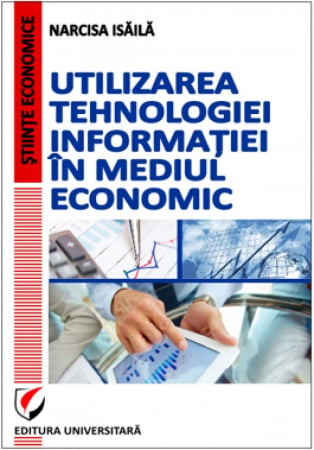ORDERS RECEIVED IN THE PERIOD 19.12.2025 - 07.01.2026 WILL BE FULFILLED STARTING ON 08.01.2026
ISBN: 978-606-28-0681-1
DOI: 10.5682/9786062806811
Publisher year: 2017
Pages: 120
Publisher: Editura Universitară
Author: Valentina Zaharia, Mihaela-Mirela Dogaru, Roxana Carmen Ionescu, Elena David
Product Code:
9786062806811
Do you need help?
0745 200 357
- Description
- Download (1)
- Authors
- Content
- More details
- Reviews (0)
In today's economy, successful businesses use three basic elements of marketing:
- Internal marketing in progress;
- Direct short-term marketing;
- Long-term media.
That is why marketing is an operational system of the activity that aims.
- Determining the current and future needs of current and potential customers;
- Study and design of products and / or services designed to meet the needs and requirements of customers;
- In production;
- In the field of standardization;
- In the field of logistics - distribution;
- Promoting these products in the right place and at the right time.
The integrated part of marketing is given by monitoring the needs before and after the process of selling and adapting products and services in the evolution of achieving business objectives. SMEs see marketing as a process that provides a certain market share.
Although the importance of the SME sector and the informal sector is recognized internationally, defining an SME is a difficult task, as each country has its own definition. There is no single, uniformly accepted definition of a small firm (Storey, 1994). Businesses differ in their level of capitalization, sales and employment. Therefore, definitions that use size measures (e.g., number of employees, turnover, profitability, and net worth) when applied to a sector could lead to the classification of all firms as small, while the same definition of size when applied to another sector it could lead to a different result.
- Internal marketing in progress;
- Direct short-term marketing;
- Long-term media.
That is why marketing is an operational system of the activity that aims.
- Determining the current and future needs of current and potential customers;
- Study and design of products and / or services designed to meet the needs and requirements of customers;
- In production;
- In the field of standardization;
- In the field of logistics - distribution;
- Promoting these products in the right place and at the right time.
The integrated part of marketing is given by monitoring the needs before and after the process of selling and adapting products and services in the evolution of achieving business objectives. SMEs see marketing as a process that provides a certain market share.
Although the importance of the SME sector and the informal sector is recognized internationally, defining an SME is a difficult task, as each country has its own definition. There is no single, uniformly accepted definition of a small firm (Storey, 1994). Businesses differ in their level of capitalization, sales and employment. Therefore, definitions that use size measures (e.g., number of employees, turnover, profitability, and net worth) when applied to a sector could lead to the classification of all firms as small, while the same definition of size when applied to another sector it could lead to a different result.
-
Small Business Marketing
Download
MIHAELA-MIRELA DOGARU, Asist. univ. drd., Universitatea Crestina Dimitrie Cantemir
VALENTINA ZAHARIA
ELENA DAVID
ROXANA CARMEN IONESCU
VALENTINA ZAHARIA
ELENA DAVID
ROXANA CARMEN IONESCU
CHAPTER 1 - Theoretical aspects. Small business past- present / 7
CHAPTER 2 - Marketing policies / 37
2.1. Promotional policy / 37
2.2. Distribution policy / 42
2.3. Product policy / 49
2.4. Price policy / 54
CHAPTER 3 - The importance of strategies for SMEs / 59
3.1. The concept of strategy and the main characteristics / 59
3.2. Strategic vision on enterprise management / 72
3.2.1. The model of the five forces of competition / 72
3.2.2. Competitive advantage and generic strategies / 81
3.3. SWOT / 95 analysis
3.4. Efficiency strategies / 99
3.5. Quality strategies / 103
3.6. Innovation strategies / 108
BIBLIOGRAPHY / 112
CHAPTER 2 - Marketing policies / 37
2.1. Promotional policy / 37
2.2. Distribution policy / 42
2.3. Product policy / 49
2.4. Price policy / 54
CHAPTER 3 - The importance of strategies for SMEs / 59
3.1. The concept of strategy and the main characteristics / 59
3.2. Strategic vision on enterprise management / 72
3.2.1. The model of the five forces of competition / 72
3.2.2. Competitive advantage and generic strategies / 81
3.3. SWOT / 95 analysis
3.4. Efficiency strategies / 99
3.5. Quality strategies / 103
3.6. Innovation strategies / 108
BIBLIOGRAPHY / 112
In today's economy, successful businesses use three basic elements of marketing:
- Internal marketing in progress;
- Direct short-term marketing;
- Long-term media.
That is why marketing is an operational system of the activity that aims.
- Determining the current and future needs of current and potential customers;
- Study and design of products and / or services designed to meet the needs and requirements of customers;
- In production;
- In the field of standardization;
- In the field of logistics - distribution;
- Promoting these products in the right place and at the right time.
The integrated part of marketing is given by monitoring the needs before and after the process of selling and adapting products and services in the evolution of achieving business objectives. SMEs see marketing as a process that provides a certain market share.
Although the importance of the SME sector and the informal sector is recognized internationally, defining an SME is a difficult task, as each country has its own definition. There is no single, uniformly accepted definition of a small firm (Storey, 1994). Businesses differ in their level of capitalization, sales and employment. Therefore, definitions that use size measures (e.g., number of employees, turnover, profitability, and net worth) when applied to a sector could lead to the classification of all firms as small, while the same definition of size when applied to another sector it could lead to a different result.
- Internal marketing in progress;
- Direct short-term marketing;
- Long-term media.
That is why marketing is an operational system of the activity that aims.
- Determining the current and future needs of current and potential customers;
- Study and design of products and / or services designed to meet the needs and requirements of customers;
- In production;
- In the field of standardization;
- In the field of logistics - distribution;
- Promoting these products in the right place and at the right time.
The integrated part of marketing is given by monitoring the needs before and after the process of selling and adapting products and services in the evolution of achieving business objectives. SMEs see marketing as a process that provides a certain market share.
Although the importance of the SME sector and the informal sector is recognized internationally, defining an SME is a difficult task, as each country has its own definition. There is no single, uniformly accepted definition of a small firm (Storey, 1994). Businesses differ in their level of capitalization, sales and employment. Therefore, definitions that use size measures (e.g., number of employees, turnover, profitability, and net worth) when applied to a sector could lead to the classification of all firms as small, while the same definition of size when applied to another sector it could lead to a different result.
If you want to express your opinion about this product you can add a review.
write a review

6359.png)
![Small Business Marketing [1] Small Business Marketing [1]](https://gomagcdn.ro/domains/editurauniversitara.ro/files/product/large/marketingul-micilor-afaceri-341-290381.jpg)














